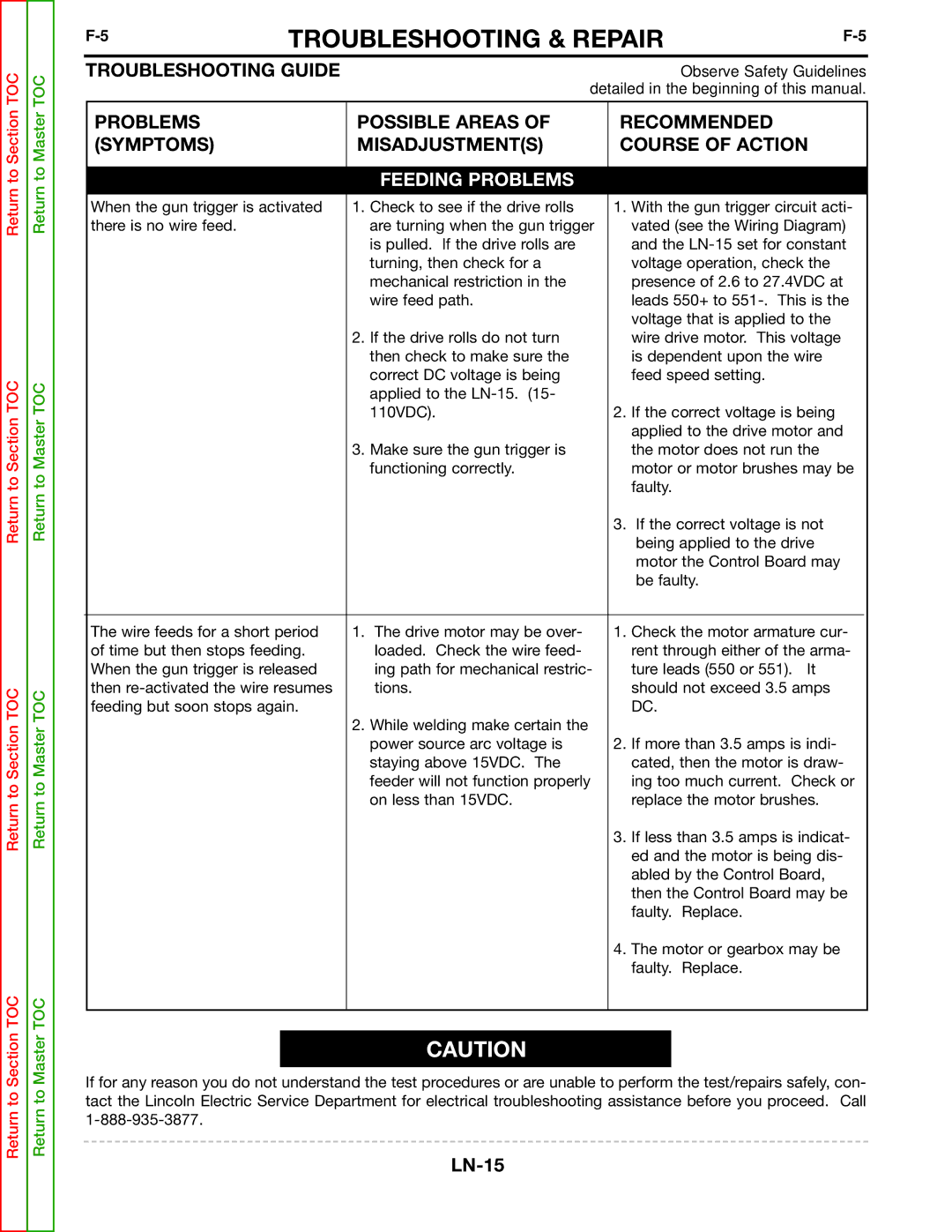
Return to Section TOC
Return to Section TOC
Return to Section TOC
Return to Section TOC
Return to Master TOC
Return to Master TOC
Return to Master TOC
Return to Master TOC
TROUBLESHOOTING & REPAIR | ||||||
TROUBLESHOOTING GUIDE |
| Observe Safety Guidelines | ||||
|
|
| detailed in the beginning of this manual. | |||
|
|
|
|
|
|
|
| PROBLEMS |
| POSSIBLE AREAS OF | RECOMMENDED |
|
|
| (SYMPTOMS) |
| MISADJUSTMENT(S) | COURSE OF ACTION | ||
|
|
|
|
|
|
|
|
|
| FEEDING PROBLEMS |
|
|
|
| When the gun trigger is activated | 1. Check to see if the drive rolls | 1. With the gun trigger circuit acti- | |||
| there is no wire feed. |
| are turning when the gun trigger | vated (see the Wiring Diagram) | ||
|
|
| is pulled. If the drive rolls are | and the | ||
|
|
| turning, then check for a | voltage operation, check the | ||
|
|
| mechanical restriction in the | presence of 2.6 to 27.4VDC at | ||
|
|
| wire feed path. | leads 550+ to | ||
|
|
|
| voltage that is applied to the | ||
|
|
| 2. If the drive rolls do not turn | wire drive motor. This voltage | ||
|
|
| then check to make sure the | is dependent upon the wire | ||
|
|
| correct DC voltage is being | feed speed setting. |
|
|
|
|
| applied to the |
|
|
|
|
|
| 110VDC). | 2. If the correct voltage is being | ||
|
|
|
| applied to the drive motor and | ||
|
|
| 3. Make sure the gun trigger is | the motor does not run the | ||
|
|
| functioning correctly. | motor or motor brushes may be | ||
|
|
|
| faulty. |
|
|
|
|
|
| 3. If the correct voltage is not | ||
|
|
|
| being applied to the drive | ||
|
|
|
| motor the Control Board may | ||
|
|
|
| be faulty. |
|
|
|
|
|
|
| ||
| The wire feeds for a short period | 1. The drive motor may be over- | 1. Check the motor armature cur- | |||
| of time but then stops feeding. | loaded. Check the wire feed- | rent through either of the arma- | |||
| When the gun trigger is released | ing path for mechanical restric- | ture leads (550 or 551). | It | ||
| then | tions. | should not exceed 3.5 amps | |||
| feeding but soon stops again. |
| DC. |
|
| |
|
|
| 2. While welding make certain the |
|
|
|
|
|
| power source arc voltage is | 2. If more than 3.5 amps is indi- | ||
|
|
| staying above 15VDC. The | cated, then the motor is draw- | ||
|
|
| feeder will not function properly | ing too much current. Check or | ||
|
|
| on less than 15VDC. | replace the motor brushes. | ||
|
|
|
| 3. If less than 3.5 amps is indicat- | ||
|
|
|
| ed and the motor is being dis- | ||
|
|
|
| abled by the Control Board, | ||
|
|
|
| then the Control Board may be | ||
|
|
|
| faulty. Replace. |
|
|
|
|
|
| 4. The motor or gearbox may be | ||
|
|
|
| faulty. Replace. |
|
|
|
|
|
|
|
|
|
CAUTION
If for any reason you do not understand the test procedures or are unable to perform the test/repairs safely, con- tact the Lincoln Electric Service Department for electrical troubleshooting assistance before you proceed. Call
